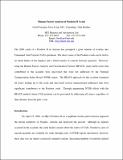Human Factors Analysis of Predator B Crash
Author(s)
Carrigan, Geoff; Long, Dave; Cummings, M.L.; Duffner, John
DownloadCP_080610_Long_et_al_AUVSI.pdf (219.9Kb)
Terms of use
Metadata
Show full item recordAbstract
The 2006 crash of a Predator B in Arizona has prompted a great amount of scrutiny into Unmanned Arial System (UAS) operations. The direct cause of the Predator crash can be tied to an initial failure of the displays and a failed transfer of controls between operators. However, using the Human Factors Analysis and Classification System (HFACS), many latent errors that contributed to the accident were uncovered that were not addressed by the National Transportation Safety Board (NTSB) report. The HFACS approach for this accident examined all issues leading up to the crash and uncovered several organizational influences that were significant contributors to the Predator crash. Through augmenting NTSB efforts with the HFACS method, future UAS incidents can be prevented by addressing all causes, regardless of their distance from the pilot’s seat.
Date issued
2008-06-10Keywords
Predator B, unmanned arial system (UAS), human factors analysis and classification system (HFACS)
Collections
The following license files are associated with this item: